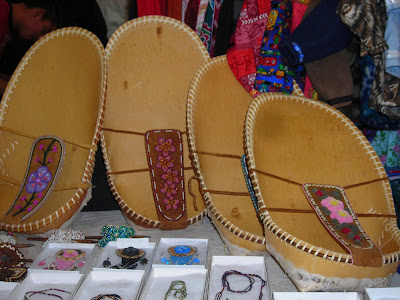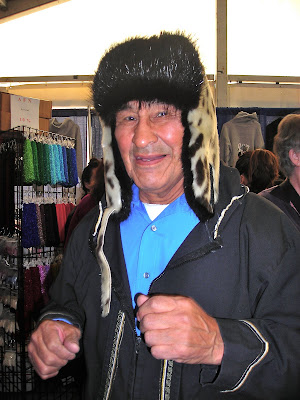An annual event in Fairbanks is the weeklong convention known as
the Federation of Alaska Natives. It coordinates with the First Alaskans Institute Elders and Youth Conference. Together they "symbolize a legacy of strength, identity and heritage in this community. What is shared today will last for generations".
More than 1,000 participants represented all five Alaska Native cultural groups. These groups came from isolated villages that stretch from the southeast fishing islands to off the western coast beyond Nome to the SW Aleutian Islands to northern Prudoe Bay and many places in the Interior. Some villages are made up of only 50 people. Most are subsistence natives, living off the land and sea as they have done for countless generations. "
Remember that there are almost no roads that run between these villages so getting here must have been interesting.
They united at this event to discuss issues that specifically affect their distinct lifestyles. This year's theme was "Indigenize it! Culture. Language. Identity." The keynote speaker was an Athabascan elder who published the Koyukon Athabascan dictionary after traveling to many villages along the Yukon river recording the Native names of places, kinships and types of subsistence activities. Her speech focused on the youth seeking information from elders, a Native practice that is fading in recent years (which I believe has also happened in our western culture). A goal was "to foster the transmission of wisdom and leadership from elders to young people aged 13-18." She said, "It gives you a feeling of belonging to know where your family comes from."
I am sure that joining together of many small groups gives renewed strength in sheer number.
Just think of groups you are part of and how they connect you to others of like mind.
I was privileged to talk with a patient that ended up unexpectantly in Fairbanks Memorial Hospital for IV antibiotics. She lived on a small island near Kenai and had been a teacher. She shared with me that a main issue being discussed this week is how to live effectively in today's world while maintaining one's heritage and unique lifestyle. I enjoyed speaking with her and I honestly can understand this conflict even in my own family.
***************************
I attended the AFN Crafts Fair and was delighted that the talented craftsmen and women were willing to talk to me about their wares and let me take their pictures. I picked out a few I thought you would appreciate seeing...
I have always called a warm winter ski-type jacket a "parka". This lady called it a "parki" (pronounced park-ee). She sewed these. Each is a coat or a cotton dress that covered a coat and it always has a little gathered skirt on the bottom edge. Sort of a feminine touch. All of the women were wearing these.

I loved the cute face of this lady. Her face was rather like the faces of her dolls. They are made out of dried sealskin and dressed in authentic clothes. Do you see the harpooning men dolls?

I could replace the word "Indian" with other adjectives to make this T-shirt work for lots of situations, can't you?

Can you guess what these are?
Baby carriers! And the warm animal furs that are sewn into baby's bunting have a special laced opening made for the "diaper" changes without exposing any other baby parts to the cold.

She was busily sewing more beautiful fur hats made of wolverine, wolf, and bear skins.
I couldn't resist getting a picture of her.

I found myself smiling at these ladies. They were so pleasant and agreeable though several couldn't speak English well. The ornaments here are real fur and the kayaks are made of seal and whale gut.

Whaling teams and harpooners are strongly united men. I admired this jacket back that had been hand stitched. Just in case you can't read it, I'll write the list of words that describe this harpooner from Tikigaq: "strong, willing, quick, provider, cautious, crew team leader, respectful helper, prayer."
Good qualities for someone who heads out onto icy waters in a handmade kayak searching for whales and large seals, I think.

When I asked this gentleman if I could photograph the back of his jacket, he teased me by acting all insulted that I only wanted his back. So I had him turn around to get a picture of his face. First he insisted that he put on the amazing seal hat that he had been holding.
The harpooner extraordinaire!

"Quyana" means thank you in Athabascan.
No comments:
Post a Comment